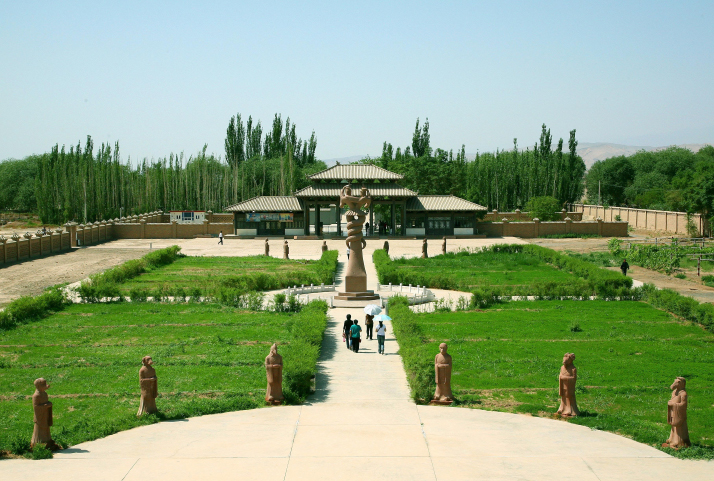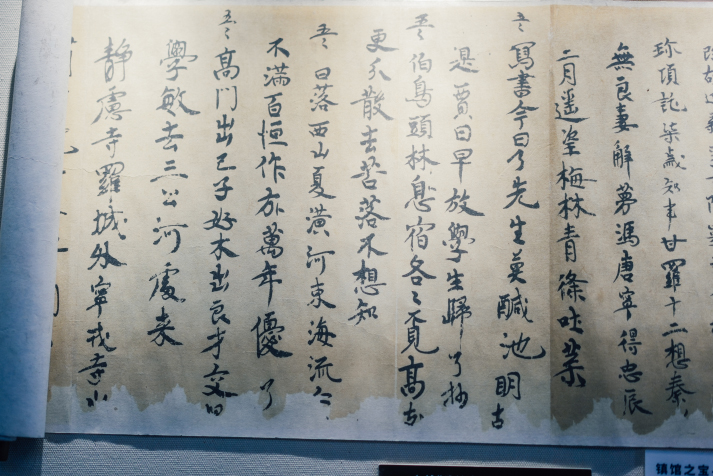| Xinjiang Today |
| Confucian legacy in the Western Regions | |
|
|
 The Astana Cemetery in Turpan City (CNSPHOTO)
As modern students flip through textbooks filled with scientific diagrams and historical timelines, one may wonder what these primers contained in ancient times. What wisdom guided education in the remote oases of Xinjiang, where camel caravans once traversed the Silk Road?
The answer lies beneath the sands of Turpan's Astana Cemetery, which includes more than 500 ancient tombs that have survived from the third to eighth centuries. Ancient text fragments have been assembled to reveal The Thousand Character Classic, a renowned work of Chinese literature. These delicate scraps preserve verses that once resonated in classrooms across China: "The darkling skies and yellow earth amid great chaos had their birth. Then Sun and Moon their courses ran; then stars were set and round they span." More than just calligraphy practice, this rhythmic composition—consisting of 1,000 unique characters arranged in 250 rhyming four-character sentences—served as a linguistic foundation and philosophical guide for generations of learners in China. These texts were essential for teaching children Chinese characters and foundational knowledge, acting as a key to their educational journey.  Homework of Tang Dynasty (618-907) student Bu Tianshou, unearthed in 1969 from the Astana Cemetery in Turpan, on diplay at the Turpan Museum (VCG)
Far and wide A five-meter scroll written by Bu Tianshou, a 12-year-old student, in 710 during the Tang Dynasty (618-907), unearthed in 1969 in the Astana Cemetery, offers a glimpse into ancient school life in Xinjiang. Bu transcribed several chapters of two books—The Thousand Character Classic and The Analects of ancient philosopher Confucius (551-479 B.C.) annotated by prominent scholar Zheng Xuan (127-200). Both were assigned readings at that time. Bu wrote a piece of doggerel at the end of the scroll: "Today's writing is done; teacher, don't blame me for being late. Tomorrow is a holiday; let the students go home early." Zheng's annotations of The Analects were lost after the Tang Dynasty. Bu's copy and other documents unearthed in Turpan have therefore provided valuable information for the study of the classic works of Confucianism, said Chen Aifeng, deputy head of the Institute of Turpan Studies in Turpan. "Most copies of The Analects annotated by Zheng unearthed from the Astana Cemetery are written by students, indicating that education in Xinjiang during the Tang Dynasty was influenced by the Central Plains culture," Chen added. The Central Plains, the part of the North China Plain surrounding the lower and middle reaches of the Yellow River, are considered the heartland of ancient China. The Western Regions are regions west of China's Central Plains, including today's Xinjiang. The spread of Confucian culture in the Western Regions began earlier than many might think. Confucian classics were introduced as far back as the Han Dynasty (206 B.C.-A.D. 220). In 1934, a bamboo slip of a chapter of The Analects was discovered at a Han Dynasty beacon site near Luobupo (Lop Nur), a lake in Ruoqiang County, Bayingolin Mongolian Autonomous Prefecture. Fragments of an Eastern Han Dynasty (25-220) copy of Strategies of the Warring States, a collection of stories and historical records from the Warring States period (475-221 B.C.) compiled in the Han Dynasty, were also found in the ruins of the ancient city of Haitou in the Luobupo area. During the Wei, Jin, and Southern and Northern dynasties (220-589), interactions between the Western Regions and the Central Plains intensified. In Turpan, numerous fragments of classical texts have been uncovered. Excavations at the Astana Cemetery have revealed tombs containing The Classic of Filial Piety, buried as guidebooks for the afterlife. Wisdom that lives on During the Yuan and Ming dynasties (1279-1644), the country was again unified, and Central Plains culture continued to spread to the Western Regions. The fragmentary pages of a copy of The Romance of the Western Chamber—China's Shakespearean love tragedy written by Yuan Dynasty (1279-1368) playwright Wang Shifu—unearthed in Qiemo County, Bayingolin Mongolian Autonomous Prefecture, are the only known physical copy handwritten by someone from the Yuan Dynasty. Numerous people revering Confucianism migrated from the Western Regions to the Central Plains. Among them were outstanding figures such as eminent translator An Zang, agronomist Lu Mingshan and statesman Lian Xixian. During the Qing Dynasty (1644-1911), the authorities renamed the Western Regions "Xinjiang," meaning "land newly returned," and established a province here in 1884. After that, officials including Zuo Zongtang and Liu Jintang vigorously promoted Confucian education, improving standard Chinese proficiency among local populations and sparking a fervor for Confucian culture. Although Confucius never set foot in the Western Regions, Confucian culture took root and flourished in this vast land, becoming a bond connecting multiple ethnic groups. This article is based on reports by Xinhua News Agency and Ts.cn, the official news website of Xinjiang, and an article published by Daozhonghua, a new media account of the National Ethnic Affairs Commission Comments to maxiaowen@cicgamericas.com |
|
||||||||||||||||||||||||||||
|